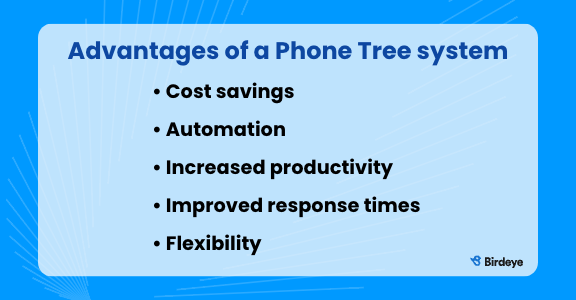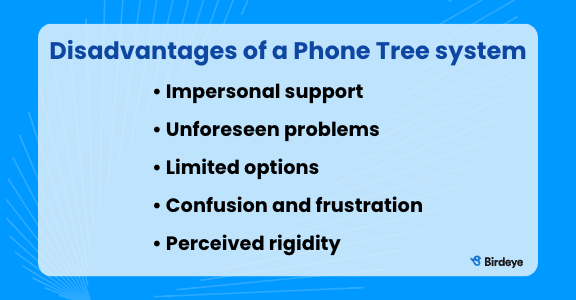Every business needs a reliable system for customer support. Phone tree systems are an increasingly popular solution, offering a cost-effective way to provide customers with the help they need quickly and efficiently.
But while these systems can be useful, there are also potential drawbacks that businesses should consider before implementing one in their organization. In this blog post, we’ll explore both the pros and cons of using a phone tree system to deliver customer service so you can make an informed decision about whether it’s right for your business.
Table of contents
What is a Phone Tree?
These systems are also known as call trees or telephone trees. It typically involves an automated menu-driven response system that customers must navigate in order to get the help they need. The customer is presented with a series of options and can select which one most closely matches their desires. The customer is then directed to the appropriate department or person with the ability to help them.
Today, automated Phone Trees are standard. They can augment or even replace traditional call centers and direct customers to relevant answers and solutions or put them through to the appropriate department for additional support. And much like website chatbots, this software can provide an added line of customer care.
Advantages of a Phone Tree system

Cost savings
Depending on your industry, supporting a call center work requires a considerable amount of workers. As a result, it can be quite expensive for a company to maintain. More cost-effective solutions are available, but they often offer lesser quality support. Turnover is also high because most people find call center work repetitive and stressful. Finding, onboarding, and training new team members can be expensive.
With a Phone Tree system, you don’t need to support as many call lines. You also don’t need to hire as many customer service and technical support personnel to monitor the lines. You can operate the system with a streamlined staff and technology that requires minimal maintenance.
Automation
Phone Tree software lets you automate many tasks, making it possible to handle a higher volume of calls without the need for additional staff. These automation capabilities include recording incoming calls, routing calls to appropriate departments, answering frequently asked questions, providing self-serve options, and collecting customer information.
Phone Tree systems can also be customized to meet specific customer needs. For example, you can set up different options based on language preference or have callers select from a list of predetermined topics that best reflect their issue. This allows customers to resolve their issues quickly without having to wait for an available support agent.
Increased productivity
Staff is able to focus on more important tasks instead of answering the high volume of calls a company might receive from their customers. Because your staff doesn’t need to handle as many incoming calls, they can focus more on high-value activities like closing sales or developing digital marketing campaigns. Phone Trees free up their time so they can be more productive with key tasks that contribute to the bottom line of your business rather than answering repetitive queries.
Improved response times
Automated systems reduce wait times and improve response times. Calling customers won’t have to take chunks of their day waiting for a live representative to answer their questions or solve their concerns. Instead, as they dial into the Phone Tree system, they’ll be greeted with pre-recorded messages directing them to the appropriate department. In some cases, the system can also provide them with the necessary information or answers to their specific questions.
Flexibility
You can customize your phone software based on the needs of your business and your customers. You can update the system ongoing with additional options. Or you can change the messaging as needed. These systems also scale well with increasing demand and growing companies.
Disadvantages of a Phone Tree system

Impersonal support
Some business models are more complex and require more hands-on support than others. When customers can’t find the help they need and are forced to navigate an endless menu, trying to find the answers they’re looking for, frustration can grow quickly. Pre-recorded messages are also highly impersonal. If your customers cannot connect directly with your staff as needed, they will feel less connected to your company.
Unforeseen problems
Like most software, automated Phone Tree systems aren’t perfect. You most likely will experience downtime. For example, your menu settings could be configured incorrectly or customers may require urgent or emergency assistance. In some cases, you may need to get your customer support team to step in to handle the call. You can’t rely on it 100% of the time if it’s your mission to offer quality customer service.
Limited options
Phone Trees work well in companies with a clear demarcation between departments and the expertise or solutions they offer. In a car dealership, sales, serve, and customer service are some of the standard customer-facing departments. Giving your customers the option of navigating through to the correct department quickly can save you, and them, time.
The system can be inefficient in companies handling more complex requests. You may not be able to offer thorough answers to certain types of questions. It may not be sufficient for managing technical issues, customer disputes, or providing product information alone.
Confusion and frustration
It has often been said that a confused mind does nothing. The temptation might be to set up your system with every possible department, solution, promotion, sales presentation, and more. For most customers, this is simply too much.
Too many options and endless menu surfing can cause frustration with customers, who either can’t find the information they need or can’t get through to the right person to handle their situation. If you’re setting up an automated Phone Tree system, you must ensure your pre-recorded messaging and menu options are clear and concise.
Perceived rigidity
Customers like being able to speak with a customer service person, technical support specialist, or sales representative, especially if they feel they have a unique concern or issue that’s technical in nature. These systems work as decision trees, and there are a limited number of inputs. Customers may find this a little too rigid, and they may even end up requiring manual support anyway.
Frequently asked questions about Phone Trees
Yes. In fact, there have been many advancements in automated Phone Tree systems. Businesses can now handle customer service and sales tasks with greater efficiency than ever before.
There are many Phone Tree software solutions available, and the cost varies depending on the service you need. The typical service costs about $24.99 to $54.99 per month. Some are cheaper. Some are more expensive.
Yes. You can set up a Phone Tree with a landline or cell phone.
Pre-recorded messages greet the caller and prompt them to navigate the menu with their dial pad or with voice commands. This system can route callers to the appropriate line or even take messages.
Connect with customers with Phone Tree software
Phone Tree systems are a great way to connect with customers and route callers to the correct line. While there can be some confusion and frustration, if you ensure your pre-recorded messaging and menu options are clear and concise, you’ll have better success with this system.
You should also consider how complex your customer requests may be when determining whether or not an automated system is right for your business. If used correctly, however, it can increase efficiency in customer service tasks while allowing users to access information quickly and easily.

Originally published









